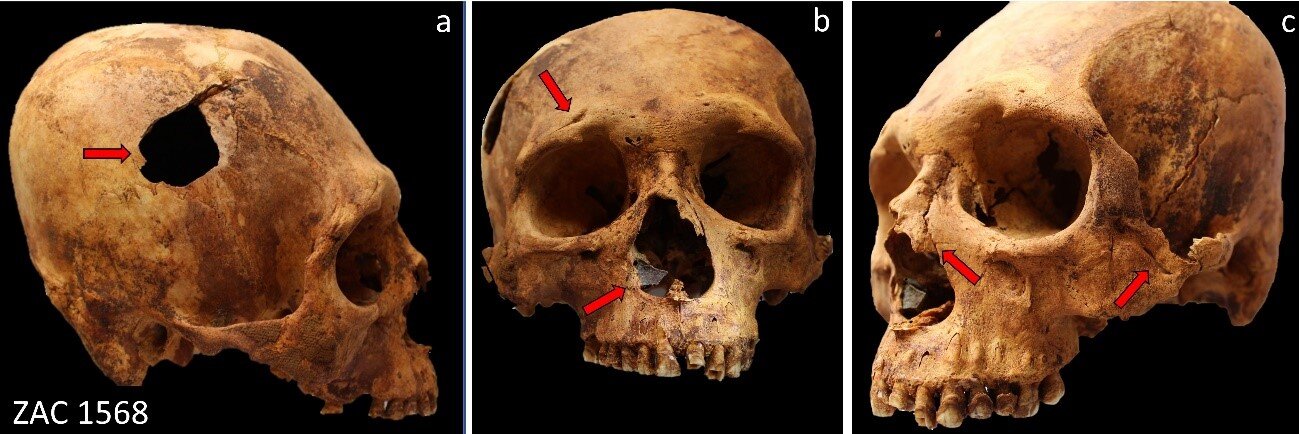The transition from the fifth to the fourth century BCE (Before the Common Era) in the Central Andes, an area now encompassing parts of Peru, appears to have been a period of significant turmoil. Researchers investigating this era, known as the Middle Formative period (1200–400 BCE), have uncovered evidence suggesting widespread violence, political disintegration, and a potential shift from theocracy to secular rule.
A recent study published in the journal Latin American Antiquity sheds new light on this critical juncture. Led by Peruvian bioarchaeologist Luis Pezo-Lanfranco, the research team comprised scholars from Peru, Colombia, and Brazil.
The cornerstone of the study involved a meticulous examination of 67 skeletons unearthed from a burial site dating back to 500–400 BCE in the Supe Valley, situated near Caral, a prominent ceremonial center active between 2900 and 1800 BCE. The skeletal analysis revealed a disturbing pattern of injuries consistent with repeated incidents of interpersonal violence. Shockingly, 80% of the examined adults and adolescents displayed evidence of fatal traumatic injuries.
Pezo-Lanfranco elaborated on these findings, suggesting that “a group of strangers” might have been responsible for the violence, targeting the community and leaving a trail of victims, including children, who were subsequently buried with traditional funeral rites by their own people.
The injuries observed were predominantly perimortem, signifying they occurred close to the time of death and showed no signs of healing. Interestingly, the study also unearthed instances of antemortem trauma, injuries sustained earlier in life that had healed, alongside perimortem injuries. This suggests that many individuals faced violence on multiple occasions.
“The markers indicate exposure to repetitive and lethal violence throughout their lives,” explained Pezo-Lanfranco. The most frequent injuries included skull fractures, facial fractures, rib and shoulder blade fractures, and defensive fractures on the ulna (forearm), likely sustained while attempting to ward off blows.
The study also noted that 64 out of the 67 individuals were buried in a fetal position, a recurring practice observed in numerous prehistoric and ancient societies worldwide. Some scholars believe this posture symbolizes rebirth after death.
Beyond the violence, bone analysis revealed a high prevalence of non-specific stress markers and infectious diseases, potentially linked to harsh living conditions brought on by resource scarcity and population growth. The simplicity of most grave goods further hinted at a community facing economic hardship. While some skeletons were buried with basic items like woven mats, gourds containing vegetables, and pottery, the overall lack of elaborate grave goods suggests a society struggling with limited resources.
The researchers believe competition for dwindling resources in the Supe Valley may have been a significant factor contributing to the collapse of the Chavín culture (1200–500 BCE), which flourished throughout the Peruvian mountains and coast. The Chavín culture centered around Chavín de Huantar, a monumental ceremonial site nestled within the Marañón River basin in northern Peru.
“The Chavín system reached a point of exhaustion during the Middle to Late Formative transition, around 500–400 BCE,” explained Pezo-Lanfranco. “Several ceremonial centers, including Chavín de Huantar itself, were abandoned and their sacred status revoked. Political structures centered around religion disintegrated, possibly marking the decline of theocracy and the rise of secular leadership.”
The Chavín people worshipped a “zooanthropomorphic” deity, a god combining human and animal features, which was a common theme in many ancient cultures across the globe. While the exact name of this deity remains unknown, some scholars speculate it might have been a later development based on prehistoric shamanistic traditions. However, the lack of decipherable written records from this era makes definitive conclusions challenging. It’s crucial to remember that this period predates the Inca Empire by nearly two millennia.
The Inca Empire, established by Pachacuti in 1438 CE (Common Era), marked the culmination of thousands of years of Andean civilization. However, its reign was short-lived, lasting less than a century before the Spanish conquest.
The significance of this study lies in its contribution to understanding a poorly documented era in Andean history. The exceptional preservation of the skeletal remains, attributed to the region’s arid climate, offers a unique window into the lives and deaths of these ancient people.
“This study falls under the purview of ‘bioarchaeology of violence,’ a field that sheds light on the nature of interpersonal conflict during this period,” said Pezo-Lanfranco. “Furthermore, forthcoming data analysis promises to reveal more about the societal factors influencing illness and mortality rates within this context of population pressure, political transformation, and a potential loss of faith amidst a resource-deprived environment.”
Source: FAPESP
